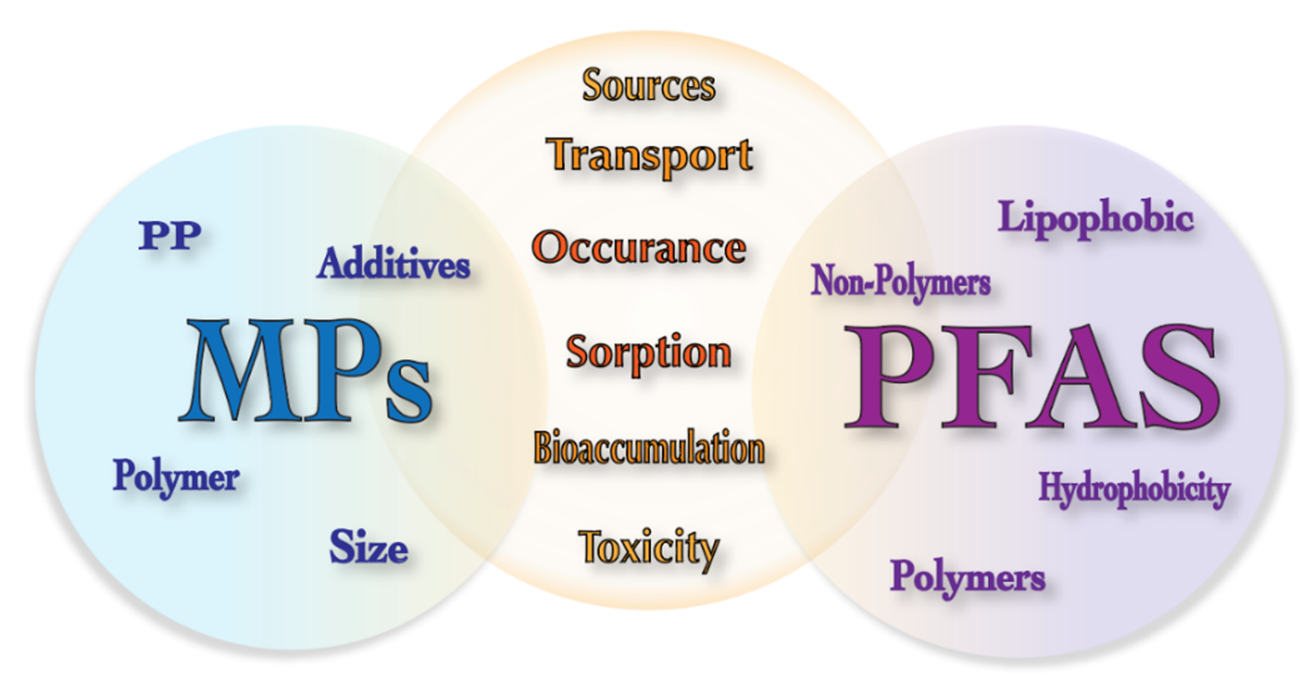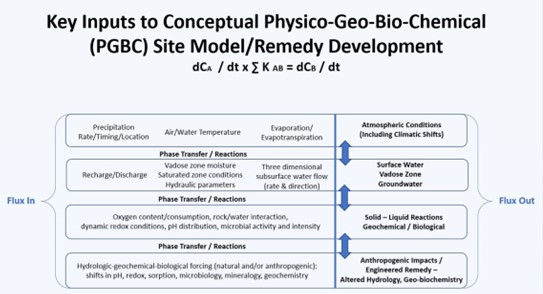Mitigating Risk Through Conceptual Site Model Adaptability within a Complex Environmental System
Two of the most noteworthy and recently emerged persistent contaminants capturing the attention of regulatory bodies, environmental scientists, the media, and the public are microplastics (MPs) and per- and poly-fluoroalkyl substances (PFAS). These pervasive pollutants, some deem as “forever contaminants,” possess remarkable similarities, including persistence, bioaccumulative potential, and their ubiquitous existence. While their individual impact on the environment has been and continues to be extensively researched, their connection and interaction remain largely understudied1. In Part 1 of this two-part blog, we embark on a journey to unravel the complex and apparent synergistic dance between PFAS and MPs, highlighting some of the current regulatory actions and assessing a sustainable Conceptual Site Model (CSM) framework within a complex environmental system to help with further evaluating the complex relationship involving these two categories of anthropogenic constituents. Part 2 of the blog (to be published in September 2023) will focus on risk management and mitigation approaches.
You can access and download BBJ’s CSM E-book here.
Unveiling the Relationship
Microplastics and PFAS may seem worlds apart, with one originating from our plastic-dominated society and the other arising from the usage and manufacturing of various industrial and consumer products, respectfully. Synthetic plastics were developed soon after the turn of the twentieth century with mass production generally occurring after World War II2. PFAS chemistry was developed in the late 1930s followed by widespread use for numerous products in manufacturing, defense, medical, and general consumer products increasing substantially in the 1950s3. While these constituents (and their many derivations) are intended for specific uses, their unintentional entry into different environmental and ecological systems became inevitable as life-cycle analyses were not part of the constituent's ultimate evaluation for use. Both categories of constituents, and their derivatives (that is, the chemical and physical transformations of the original constituents) can travel from their origin points through multiple transport mechanisms such as, but not limited to, soil deposition4, wind distribution of fugitive dust5, and leaching into subsurface and surface water environments6. Monitoring has also shown the constituents tend to accumulate within more developed areas (potentially leading to higher levels of contamination and exposure risks1), with both PFAS and MPs also detected at the highest elevations7 on Earth and broadly throughout the Earth’s seas and oceans8. It is also imperative to remember that improper disposal of anthropogenically generated waste9, such as in landfills or wastewater treatment facilities, can contribute to further dissemination and widespread existence1. When PFAS and MPs coexist in the environment, they create additional and sometimes synergistic conditions related to transport, fate, and transformations in the environment. Some of these conditions may also strengthen the persistence and increase the distribution of these constituents1 (Figure 1).
The Invisible Bonds
While the documented impacts of MPs and PFAS, individually, are becoming more widely known, their interaction remains enigmatic. As scientists delve into this collusion, many questions have arisen. Are MPs serving as carriers for PFAS, increasing their mobility and enhancing their potential to spread throughout ecosystems? Can the presence of PFAS in the environment alter the face and behavior of microplastics, affecting their distribution and potential harm?
Kang et al., in 20231 recently determined that PFAS and MPs can adsorb and sorb substances onto their surfaces. PFAS, being hydrophobic in nature, have an affinity for organic compounds like MPs. Another mechanism, electrostatic interaction, may also increase the interaction between the constituents as the charged functional groups of anionic, cationic, and zwitterionic PFAS can be drawn toward the charged surfaces of MPs1,10,11. When both PFAS and MPs have neutral charges on their surfaces, neutral electrostatic interactions can occur between them. The organofluorine molecule charge, as well as the length, structure, and MP surface chemistry, can affect the interaction between them. Other environmental factors, such as the presence of organic matter and pH can also influence the strength and nature of these interactions10,11.
For both types of interactions, PFAS may adhere to the surface of MPs, potentially amplifying each constituent’s concentration in the environment. The research into understanding how these interactions influence behavior and fate within the environment under varying in-situ conditions continues to be a primary interest1.

Figure 1- The overlap and interactions between MPs and PFAS; where the central yellow circle indicates the overlap and mechanisms of interaction and blue and purple circles encapsulate individual characteristics of MPs and PFAS, respectively. Modified from Kang et al., 20231.
Navigating Regulatory Waters
Regulators strive to keep pace in an era of rapidly evolving information on the occurrence, distribution, risk, fate, migration, and risk potential of emerging contaminants. Analyzing risks associated with new industries, novel substances, and uncharted territories, they shoulder the burden of ensuring safety amidst uncertainties.
Regulatory action is the process through which authorities promote safeguards to public health and the environment. Each action requires a harmonious blend of science, legislation, and application with jurisdictions in different geographies often taking different tactics to implement regulatory guidance and action. Examples of the current actions being taken include, but are not limited to, the following:
- The Environmental Protection Agency (EPA) in the United States has established a lifetime health advisory level of 70 parts per trillion (ppt) for common two PFAS (i.e., PFOA and PFOS) in drinking water. The EPA is also establishing regulatory limits for six different PFAS in drinking water, in accordance with the Safe Drinking Water Act12. If adopted, it would establish exceptionally low concentration values on the order of low “parts per trillion” maximum contaminant levels.
- Several states, such as California and Michigan, have been at the forefront of developing enforceable regulations on PFAS due to concerns about the health and environmental impact. Many of these regulations focus on setting maximum contaminant levels (MCLs) for specific PFAS compounds in drinking water.
In addition to drinking water regulations, various states are also working on regulations related to PFAS contamination in other environmental media, such as groundwater, surface water, and soil. Some states have implemented or are considering regulations related to the cleanup of PFAS-contaminated sites, monitoring and reporting requirements, and restrictions on the use of PFAS in certain products or industries13. - Certain PFAS compounds have been included in the list of substances of extremely high concern under the REACH (Registration, Evaluation, Authorisation and Restriction of Chemicals) regulation by the European Union, which has taken regulatory action on PFAS. This inclusion paves the way for restrictions on the production, use, and marketing of these substances14.
- The European Union has implemented important regulations concerning microplastics. In 2021, the EU's Single-Use Plastics Directive was implemented, prohibiting various single-use plastic products and enforcing extended producer responsibility policies for specific plastic items. Additionally, the directive includes guidelines regarding MPs, such as mandatory labeling for products containing intentional microplastics15.
- Several countries, including Canada and Australia, have introduced regulations or bans on including microbeads in personal care products, citing their negative impact on aquatic ecosystems through the release of microplastics16.
- Various global organizations, including the United Nations Environment Programme (UNEP), are developing guidelines to tackle the problem of microplastic pollution. UNEP's Global Partnership on Marine Litter is committed to reducing marine litter, including microplastics, through international collaboration and policies17.
Sampling and analytical techniques for Microplastics and PFAS
Monitoring and tracking the presence of MPs and PFAS in the environment present unique challenges. The need for both constituents to utilize specific monitoring techniques and advanced analytical methods further compounds the limitations of cost and time consumption. Moreover, the pervasive presence of these constituents in various sources complicates the process of tracing and tracking their existence. Here are some notable variations among the methods used to detect these contaminants:
Microplastics:
- The National Oceanic and Atmospheric Administration (NOAA) in the United States has established a procedure for gathering and examining MPs in seawater and sediment samples. This involves filtering the samples, visually identifying, and categorizing the MPs, and measuring their concentration. Techniques such as Fourier transform infrared spectroscopy (FTIR) can then be employed to identify the polymer composition of the MPs18.
- There are several techniques used for identifying and determining the concentration of MPs in different substances. Examples of these techniques include FTIR, Raman spectroscopy, and pyrolysis-gas chromatography-mass spectrometry (Py-GC-MS). These methods are useful in characterizing MPs according to their chemical composition, color, shape, and size18.
PFAS:
- The EPA’s Draft Method 1633 is a comprehensive analytical method for the detection and quantification of PFAS in water, soil, sediment, and solid materials. It employs isotope dilution anion exchange solid phase extraction (SPE) and liquid chromatography-tandem mass spectrometry (LC-MS/MS) to accurately measure multiple PFAS compounds simultaneously. This draft method proves standardized procedures and quality control measures for PFAS analysis, ensuring reliable and comparable data across different laboratories19.
- The European Union Reference Laboratory for Alternatives to Animal Testing (EURL ECVAM) has developed a method for the detection of PFAS in food and feed samples using high-performance liquid chromatography-mass spectrometry (HPLC-MS/MS). This method analyzes a wide range of PFAS in intricate matrices20.
- The National Measurement Institute (NMI) in Australia has produced a technique for analyzing PFAS in environmental samples by utilizing a combination of liquid chromatography and high-resolution mass spectrometry (LC-HRMS). This approach is highly effective in detecting a variety of PFAS in soil, water, and biota, and ensuring accurate results in samples21.
The use of analytical methods to determine the extent of contamination is essential for developing effective CSMs, which in turn, are used to assess the risk and mitigation strategies.
CSM: Piecing Together the Environmental Puzzle
The CSM plays a pivotal role in an environmental assessment as it is arguably the most essential organizational tool for creating a road map to characterize a site for contaminant sources, migration pathways, potential receptors, future scenarios, and risk mitigation (including remediation) strategies. Crafting an accurate and representative CSM is akin to assembling a jigsaw puzzle where misplaced pieces may lead to inaccurate results, but where missing pieces highlight uncertainty as a problem in knowing what an accurate picture looks like. Lack of clarity and lack of confidence in site characterization, whether for PFAS, MPs, or other constituents not only limits the number of alternatives available for mitigating a problem but could exacerbate the economic cost by leading to the selection of an overly conservative potential remedy that may be substantially overdesigned to accompany the high degree of uncertainty that describes a given contaminant problem. However, perfection is not the objective of the CSM, and in fact, its pursuit may be detrimental – but increased clarity and confidence, even if not complete, leads to better and more protective risk management outcomes.
Here are a few of the challenges when constructing a thorough CSM regarding MPs and PFAS:
- Lack of Comprehensive Data: MPs and PFAS are emerging contaminants, and their occurrence, behavior, and interaction in the environment are not fully understood. Limited data availability, or inaccurate analysis related to their sources, pathways, fate, and transport can hinder the development of an accurate CSM.
- Environmental Conditions: Physical, geochemical, and biological conditions including temperature, pH, reduction-oxidation conditions, and presence of organic matter content22 among other parameters, can influence the behavior of both MPs and PFAS. These conditions can fluctuate spatially and temporally, making it challenging to develop universal CSMs that can capture this variability.
- Analytical Limitations: Analytical techniques for MPs and PFAS detection are continually evolving, and not all contaminants within these classes can be easily measured. This can result in data gaps and uncertainties in estimating the breadth and depth of their concentration.
- Cumulative and Synergistic Effects: The physical degradation of MPs and the chemical transformation of PFAS may interact and synergize. Investigating if the presence of MPs enhances or accelerates the transformation of PFAS or vice versa is complicated and relies on further research. However, considering the potential synergistic behavior is just as important for developing an effective CSM.
Navigating through the intricacies of regulatory action and CSM development may seem like an arduous endeavor, but amidst challenges lies innovation.
Advanced analytical techniques, such as machine learning, are also emerging alongside these contaminants and they hold great promise in unlocking insights and data reservoirs. However, there are some components that still need to be addressed when forging a new CSM framework. Historically, remediation design processes have often overlooked the impacts of fluctuating climatic, hydrological, and biogeochemical characteristics and how the transient nature of these compartments influences contaminants such as MPs and PFAS. Developing a new CSM framework, to acknowledge the influence of anthropogenic stresses and processes (Figure 2) on the hydrobiogeochemical environment as it changes throughout time is key for a remedy to be resilient and durable23.

Figure 2 - Framework development of the PGBC site model that incorporates physical, chemical, and biological stress on phase transfers and reactions. CA and CB represent the chemical fate at the initial and next time steps, while ΣKAB is the sum of climatic influence integrated over time (Taken from Warner et al., 202323).
Check out how BBJ Group’s Jenna Chaffeur explains the integration of Mass Flux into a CSM framework.
Summary
Plastic is everywhere, and MPs, whether developed by intention or as a physical degradation part of larger plastic components are being described as ubiquitous in the environment. Factors such as UV radiation, mechanical abrasion, and microbial activity can reduce the size of the particles, but full degradation is elusive24.
PFAS are compounds that have exceptional chemical stability due to their C-F bond25, which also makes PFAS difficult to break down in the environment. However, certain environmental processes can partially transform via several mechanisms such as photolysis, hydrolysis, and biodegradation26.
As science is finding, while PFAS and MPs are different substances that have environmental impacts, their interactions with each other within the environment are creating additional complications regarding environmental health and protection. The degradation of MPs leads to the release of smaller particles, including nano plastics, which can carry PFAS compounds and contribute to further distribution and deposition1. Furthermore, PFAS undergo chemical transformations in the environment leading to the formation of more persistent compounds that can adhere to the microplastics and affect their toxicity, which creates dynamic and complex pollution ubiquitously1.
Constructing an accurate CSM framework that considers a transient environment requires careful consideration of numerous factors, including the individual impacts of MPs and PFAS and their synergistic effects. Anthropogenic stresses, such as the release of these substances into the environment, must be accounted for to accurately assess the risks they pose23. To identify how MPs and PFAS move throughout the environment, several steps can be taken to understand their pathways:
- Literature Review: To learn more about the sources, behavior, and fate of MPs and PFAS in the environment, examine the scientific literature available. This will provide a foundation for understanding the potential pathways these pollutants may take.
- Sampling and Analysis: Gather samples from a range of environmental media, including the biota, soil, water, air, and sediment. Use the proper analytical methods to analyze them to find and measure the presence of MPs and PFAS. The extent and distribution of these contaminants in various environmental compartments are determined by this stage.
- Field Investigations: Conduct field investigations to acquire additional data on MPs and PFAS probable sources and pathways. Site visits, stakeholder interviews, and observations of industrial or anthropogenic activities could contribute to the release of these pollutants into the environment.
- Modeling Approaches: To simulate the movement and dispersion of MPs and PFAS, use modeling techniques including fate and transport models. Based on a variety of variables, these models can aid in predicting the potential paths. A successful model will need a thoroughly designed and precise CSM.
- Monitoring Programs: PFAS and MPs can be monitored over an extended period using long-term monitoring methods. Identifying temporal changes and potential plumes includes routinely sampling and analyzing environmental media.
- Collaborative Research: Collaborate on research projects with professionals from a range of fields, such as engineering, chemistry, toxicology, and environmental science. Considering the intricacy of MP and PFAS interactions with the environment, this interdisciplinary approach can offer useful insights into the routes of MPs and PFAS.
Creating a CSM framework to acknowledge the influence of anthropogenic behavior and processes on the hydrogeochemical environment as it changes through time21 will result in efficient risk management techniques and a remedial approach, which we will discuss in Part 2. Developing a CSM is inevitable as our comprehension of the intricate relationships between environmental contaminants and ecological systems advances.
2 Polymer History: Designed Monomers and Polymers: Vol 11, No 1 (tandfonline.com)
3 Historical and current usage of per‐ and polyfluoroalkyl substances (PFAS): A literature review - Gaines - 2023 - American Journal of Industrial Medicine - Wiley Online Library
4 https://www.sciencedirect.com/science/article/pii/S0048969721025158
5 https://www.sciencedirect.com/science/article/pii/S2468584421000817#bib15
8 https://link.springer.com/article/10.1007/s11356-023-28314-1
9 https://www.sciencedirect.com/science/article/pii/S0269749122000744
10 https://www.sciencedirect.com/science/article/pii/S2667010021000214
11 https://www.sciencedirect.com/science/article/abs/pii/S0039914018312451
12 https://www.epa.gov/sdwa/drinking-water-health-advisories-pfoa-and-pfos13 https://www.bclplaw.com/en-US/events-insights-news/pfas-update-state-soil-concentration-regulations-july-2023.html
14 https://echa.europa.eu/substance-information/-/substanceinfo/100.251.389
15 https://eur-lex.europa.eu/eli/dir/2019/904/oj
16 https://www.dcceew.gov.au/environment/protection/waste/plastics-and-packaging/plastic-microbeads
17 https://www.unep.org/resources/report/global-partnership-marine-litter
18 https://repository.library.noaa.gov/view/noaa/10296
19 https://www.epa.gov/system/files/documents/2021-09/method_1633_draft_aug-2021.pdf
22 https://chemrxiv.org/engage/chemrxiv/article-details/640e7b92e53eff1af309157d
24 https://www.sciencedirect.com/science/article/pii/S0269749122003736
25 https://www.sciencedirect.com/science/article/pii/S0960852421015650
26 https://www.sciencedirect.com/science/article/pii/S2213343722000744




